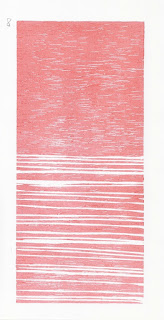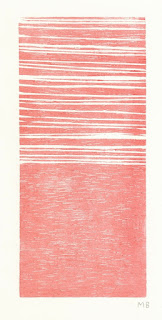I spent a few hours yesterday testing my home-made barens and comparing them to the professional-grade Murasaki (strong) and the ball-bearing barens that I already own.

These tests were performed on damp, double-weight, coated bond paper for inkjet papers.
It's what I use for demos and proofing as it is easy to register and prints well when damp.
Then the heavier barens were also tested on Magnani Incisioni, a 190g/m2 etching paper that I use for some of my smaller moku hanga works and that prints well when a good baren is used with lots of pressure.
Not surprisingly, the best impressions, cleanly and efficiently printed with little effort were with my $150 Murasaki Baren. More suprising, instead, was learning that my twisted-cord Barens all worked reasonably well. They needed more work and rubbing and left a lighter impression but improved greatly by printing twice.
My Thumbtack baren was too strong for this small piece of wood, printing over the grain and causing the paper to slip. With extra care to keep the paper from moving, it also gave a decent impression.
My Ball-Bearing baren was surprisingly weak on thick paper.
My twisted-cord barens all performed surprisingly well for a cheap baren made from humble materials and designed to be suitable for beginning users.
They needed more concerted pressure to get an impression, but with TWO passes, yielded very satisfactory results. This impression is from my nylon twisted-cord baren, printed Twice.
 |
| Baren #4, printed twice. |
 |
| Baren # 8 Hemp cord and vinivil |
But with care to make sure the paper didn't move, the impression was good, but heavy. The wood grain was partially lost, and there is some color that squished out here and there from the heavier pressure.
 | |
| Thumbtack Baren, Rives etching paper. |
 | |
| Thumbtack Baren/Bond paper |
 | ||||
| Thumbtack baren, suji and slippage. |
The Murasaki Baren printed cleanly on both the etching and bond papers.
Surprisingly, My expensive ball-bearing baren was the weakest:
 | ||||||||
| Ball-Bearing baren |
This was not a blinded test. I knew which baren I was using and varied the pressure and effort of rubbing to match the baren. My goal was to find out if I could get a decent impression from each baren not how they would all print with the same effort.
I'd like to go back and retest the ball-bearing and thumb tack barens to see how they perform on normal and medium-weight washi and with bigger passages of printed color.
Another fun test would be to print a small batch of prints, using different barens for each copy but on the same paper. This would allow me to see the tonal variations of the various barens in multiblock prints.
I'd also like to print a big section of color using them to see how the tack baren performs when really worked hard.



I'm surprised the ball bearing baren didn't do better, too. I would give it another shot - maybe you were just tired after all the previous testing - lol Seriously, I've had good luck with it even on BFK, but I had to put all of my 125 lbs.
ReplyDeletebehind it!
I'm interested to know if you subsequently got better results using the ball bearing baren. I recently got one from a print shop in Tokyo but haven't yet found the right combination of pressure and paper to avoid the baren suji and weak results you encountered. Any tips?
ReplyDelete